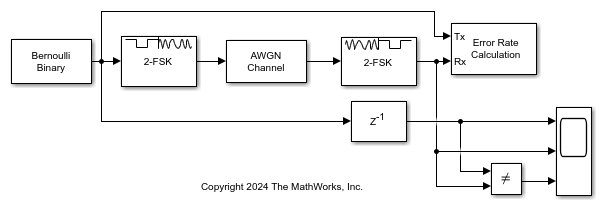M-FSK Demodulator Baseband
Demodulate FSK-modulated data
Libraries:
Communications Toolbox /
Modulation /
Digital Baseband Modulation /
FM
Description
The M-FSK Demodulator Baseband block demodulates a signal that was modulated using the M-ary frequency shift keying (M-FSK) method. The input and output are discrete-time signals.
Examples
Ports
Input
Output
Parameters
Block Characteristics
Data Types |
|
Multidimensional Signals |
|
Variable-Size Signals |
|
More About
Tips
The M-FSK Demodulator Baseband block implements a noncoherent energy detector. To obtain the same BER performance as that of coherent FSK demodulation, use the CPFSK Demodulator Baseband block.
Algorithms
Demodulation of M-FSK-modulated signals is performed by using noncoherent detection, which configures an energy detector that does not exploit phase measurements. The demodulator knows that M possible waveforms were transmitted and must decide which is received during each time duration T.
As described in Sklar [1], the general analytical expression for M-FSK modulation is
E is the symbol energy.
T is the symbol time duration.
ωi is the frequency term that has M discrete values.
M is the modulation order and specifies the number of waveforms.
ϕ is the phase offset.
The noncoherent energy detector of the M-FSK demodulator selects decision regions for each ωi waveform based on which decision region yields the maximum output.
For more details, see the Noncoherent Detection of FSK section in Sklar, [1].
References
[1] Sklar, Bernard. Digital Communications: Fundamentals and Applications. 2nd ed. Upper Saddle River, NJ: Prentice-Hall PTR, 2001.
Extended Capabilities
Version History
Introduced before R2006a


